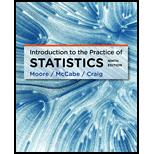
Concept explainers
(a)
To find: The degree of freedom and outline the ANOVA table with the sources of variance.
(a)
Answer to Problem 10E
Solution: The degree of freedom for factor sex is 1 and for age, the degree of freedom is 2. The degree of freedom of interaction factor is 2.
Explanation of Solution
Calculation: For the provided data, the error term can be calculated as:
The degree of freedom for Sex can be calculated as:
The degree of freedom for Age can be calculated as:
The degree of freedom for Interaction can be calculated as:
The ANOVA table with different sources of variance and degree of freedom is as follows:
Sources |
Degree of freedom |
Sex |
1 |
Age |
2 |
Interaction |
2 |
Error |
60 |
Total |
65 |
(b)
To find: The degree of freedom and outline the ANOVA table with the sources of variance.
(b)
Answer to Problem 10E
Solution: The degree of freedom for week after harvest is 4 and for amount of water, the degree of freedom is 1. The degree of freedom of interaction factor is 4.
Explanation of Solution
Calculation: For the provided data, the error term can be calculated as:
The degree of freedom for Week after harvest can be calculated as:
The degree of freedom for Amount of water can be calculated as:
The degree of freedom for Interaction can be calculated as:
The ANOVA table with different sources of variance and degree of freedom is as follows:
Sources |
Degree of freedom |
Week after harvest |
4 |
Amount of water |
1 |
Interaction |
4 |
Error |
20 |
Total |
29 |
(c)
To find: The degree of freedom and outline the ANOVA table with the sources of variance.
(c)
Answer to Problem 10E
Solution: The degree of freedom for factor mixture is 5 and for freezing/thawing, the degree of freedom is 2. The degree of freedom of interaction factor is 10.
Explanation of Solution
Calculation: For the provided data, the error term can be calculated as:
The degree of freedom for Mixture can be calculated as:
The degree of freedom for freezing /thawing can be calculated as:
The degree of freedom for Interaction can be calculated as:
The ANOVA table with different sources of variance and degree of freedom is as follows:
Sources |
Degree of freedom |
Mixture |
5 |
freezing/thawing |
2 |
Interaction |
10 |
Error |
36 |
Total |
53 |
(d)
To find: The degree of freedom and outline the ANOVA table with the sources of variance.
(d)
Answer to Problem 10E
Solution: The degree of freedom for factor different colored tags is 3 and for the type of buyers, degree of freedom is 1. The degree of freedom of interaction factor is 3.
Explanation of Solution
Calculation: For the provided data, the error term can be calculated as:
The degree of freedom for different colored tags can be calculated as:
The degree of freedom for the type of buyers can be calculated as:
The degree of freedom for Interaction can be calculated as:
The ANOVA table with different sources of variance and degree of freedom is as follows:
Sources |
Degree of freedom |
Different colored tags |
3 |
Type of buyers |
1 |
Interaction |
3 |
Error |
130 |
Total |
137 |
Want to see more full solutions like this?
Chapter 13 Solutions
Introduction to the Practice of Statistics
 MATLAB: An Introduction with ApplicationsStatisticsISBN:9781119256830Author:Amos GilatPublisher:John Wiley & Sons Inc
MATLAB: An Introduction with ApplicationsStatisticsISBN:9781119256830Author:Amos GilatPublisher:John Wiley & Sons Inc Probability and Statistics for Engineering and th...StatisticsISBN:9781305251809Author:Jay L. DevorePublisher:Cengage Learning
Probability and Statistics for Engineering and th...StatisticsISBN:9781305251809Author:Jay L. DevorePublisher:Cengage Learning Statistics for The Behavioral Sciences (MindTap C...StatisticsISBN:9781305504912Author:Frederick J Gravetter, Larry B. WallnauPublisher:Cengage Learning
Statistics for The Behavioral Sciences (MindTap C...StatisticsISBN:9781305504912Author:Frederick J Gravetter, Larry B. WallnauPublisher:Cengage Learning Elementary Statistics: Picturing the World (7th E...StatisticsISBN:9780134683416Author:Ron Larson, Betsy FarberPublisher:PEARSON
Elementary Statistics: Picturing the World (7th E...StatisticsISBN:9780134683416Author:Ron Larson, Betsy FarberPublisher:PEARSON The Basic Practice of StatisticsStatisticsISBN:9781319042578Author:David S. Moore, William I. Notz, Michael A. FlignerPublisher:W. H. Freeman
The Basic Practice of StatisticsStatisticsISBN:9781319042578Author:David S. Moore, William I. Notz, Michael A. FlignerPublisher:W. H. Freeman Introduction to the Practice of StatisticsStatisticsISBN:9781319013387Author:David S. Moore, George P. McCabe, Bruce A. CraigPublisher:W. H. Freeman
Introduction to the Practice of StatisticsStatisticsISBN:9781319013387Author:David S. Moore, George P. McCabe, Bruce A. CraigPublisher:W. H. Freeman





